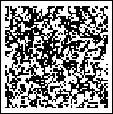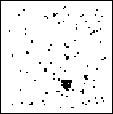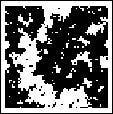
Statistical mechanics, complex systems and econophysics
My field of research is Lattice Quantum Chromodynamics, in which the dynamics of quarks and gluons are simulated. These particles make up nucleons, protons and neutrons, which in combination with electrons form atoms. This simulation uses techniques from the field of statistical mechanics, which is used to describe the behaviour of systems with many components, to obtain quantitative results such as the masses of said nucleons, through the connection between the averaging over a statistical ensemble and the integration of Feynman's path integrals.
Another area where techniques of statistical mechanics can be applied is in economics, which is of course highly relevant to our everyday lives. As well as governing our job opportunities, the wellbeing of the economy can statistically determine to some extent our own health and wellbeing as a populace. It also shapes the economic and social politics which may itself have effects that last for decades or more. It is therefore of premium importance to monitor and model the economy and to try to avoid or abate economic crashes. In this blog entry, I will explore the topic of financial crashes that underlines some connections between economics, statistical mechanics and complex systems.
First, a disclaimer: I am in no way claiming any expertise in economics or indeed in complex systems. I felt that the fundamentals of Lattice QCD were explained so well in Floriano's blog that it was pointless to try to reexplain the basics, and through research for the blog, I decided to have a bit of fun by diving headfirst into the wonderful world of econophysics. It is worth noting that the arguments put forth in this blog entry are from the "fractal school" of the market analysis of finance, pioneered by Mandelbrot. This is an alternative to other more traditional schools of thought on the subject like the efficient market hypothesis, an approximation that all prices reflect all available information; financial bubbles cannot be explained within this approximation.
Complex system analysis studies the behaviour of a system with many components that interact with each other. These interactions may be nonlinear in nature, making the system difficult to model using more conventional techniques.
In an economic model, we may distinguish between endogenous and exogenous variables. Exogenous variables are factors whose origin lies externally to an economic model, and are then imposed upon the model. Earthquakes for example may be described as exogenous. On the other hand, an endogenous variable is innate to a model, and its value is determined by the model. A topical example: we may decide to model our economy with the current Covid-19 epidemic as an exogenous factor. This is necessarily a simplification of the complex interplay between human society and the biosphere from which plagues emerge. We may also enrich our model by accounting for the endogenous factors of urbanisation and globalisation etc. that hasten its spread. If we found a link between the origin of a particular epidemic and, for example, animal agriculture, we could call it an endogenous factor of the current system of agricultural production.
Speculative bubbles, as D. Sornette of the University of California explains in his book "Why Stock Markets Crash", are created by investors who expect an unrealistic future return on present investment. The bubble grows due to the positive feedback effects endogenous in the system, such as 'herding' to buy stocks during bubble growth and to sell during a crash. These behaviours do not require any conscious coordination of the individual investors but are instead encouraged by the self-organising system. This sort of behaviour drives the system away from a stable state to an unstable state, where a crash may be triggered by small, local exogenous effects. The bubble may alternatively end by a continuous regime change, i.e. a crash is not necessarily inevitable. Decelerating market devaluations, so-called "anti-bubbles", can also be described by the same "log-periodically decorated" power law as found for accelerating bubbles. Financial crashes have been shown to belong to a different distribution to small-scale market fluctuations, giving us some distinction in scale which can be converted into predictive power.
In contrast, some systems are impossible to predict outright. Earthquakes may be an example of this. The philosophy behind this is that earthquake events display a self-similarity in scale, meaning that large earthquakes are only the continuation of small earthquakes. As the nucleation is identical, the catastrophic large earthquakes are not a priori distinguishable from small earthquakes. One can rather forecast the probability of an earthquake happening within a given relatively large period of time.
According to this theory, a financial crash is characterised by a critical point, in this case in the time domain. As the system evolves in time ever closer to this point, the probability of a crash increases, as the system becomes more unstable with respect to small perturbations. At the critical point, a phase transition occurs, corresponding to a crash. The phases in this case are a "sell" regime, where supply outweighs demand, and a "buy" regime, where demand outweighs supply. Power laws govern largely the behaviour of the variables of the system, such as price, volatility and crash hazard rate, around the critical point. This power-law evolution, however, is difficult to detect in practice due to the inherent noise of the system. It is therefore beneficial to look for other characteristic indicators of an impending financial crash.
There are, fortunately, other indications of a system moving closer to the critical point. As mentioned earlier, bubbles can be characterised by a "log-periodic decorated" power law. This means that the basic power law is 'decorated' by a 'log-periodic' oscillation, with a frequency that increases as the system approaches the critical point. This decoration can provide another indication of an impending crash which is more discernable over a background of noise.
As explained in D. Sornette's book, this is a general feature of 'models of cooperative behaviours resulting from imitation between agents organised within a hierarchical structure'. Here, the hierarchical structure refers to the presence of actors who operate with differing sizes of investment. Take, for instance, the difference in scale between an individual investor and an investment bank. The origin of this log-periodicity could emerge from the impact of analysts that seek to restore the price to its fundamental value, which, in combination with trend-following strategies e.g. positive feedback or herding, overshoots the target with increasing frequency as the price accelerates. More formally, log-periodicity is a general feature of systems with discrete scale invariance, meaning a discrete scaling factor of self-similarity i.e. the magnifying factor from one level to the next. For example, log-periodic decorated power laws are also observed in self-similar models of the Ising type familiar to all those who have taken courses in statistical mechanics.

Discrete self-similarity in investment model
The renormalisation group approach forms a major part in statistical mechanics, as well as in quantum field theory. It is based upon the change of system variables with scale, and is used to probe the critical phenomena of a system. Using as an example a spin system on a lattice, we can change the scale of observation of the system by 'blocking', meaning that we take the average of a block of adjacent lattice sites, and treat this average as a new site on a sparser lattice. The state of the system after blocking therefore depends upon the state of the system before blocking.
The critical point of this spin system is given by a certain critical length scale. The correlation length of a system is the characteristic length at which the spins are correlated i.e. point in the same direction. Depending upon how the correlation length compares to the critical length, the system will evolve in different ways due to blocking.
We have three cases:
1) L < Lc: With blocking the system is driven away from criticality, becoming more disordered.



2) L > Lc: With blocking the system is driven away from criticality, becoming more ordered.



3) L = Lc: With blocking the system remains at the critical length scale, remaining at the same level of order. This regime of criticality shows self-similarity, meaning it is scale-invariant for continuous changes in scale. The structure of the lattice correlations is fractal.



For all values apart from L = Lc, the 'renormalisation group flow' drives the system away from the critical value, with a speed of seperation from the critical point characterised by the critical exponents for different quantities. Therefore, modelling the renormalisation flow allows us to quantify the critical exponents that characterise the critical point.
It turns out that the log-periodic decorated power law is equivalent to the projection onto the real plane of the observable of the real order parameter (L - Lc) taken to the power of a complex exponent. This corresponds to a change in magnitude and a rotation around the complex plane as the magnitude of the order parameter decreases i.e. as we get closer to the critical point. The oscillations in the real observable are manifestations of projections from rotation in the complex plane. This rotation stems from the exponent, leading to log-periodic oscillations in the observable, meaning that there is a regular oscillation in the logarithm of the observable. Discrete scale-invariance is a property of complex critical exponents just as continuous scale-invariance at the critical point corresponds to a real critical exponents.
In this blog post, I have talked about some methods of potentially predicting financial crashes through the use of methods from physics. Within the above theory, some markets are intrinsically instable due to endogenous factors, which are practically impossible to change within a system due to the self-organistion of the system. The instability may therefore be solvable through either control of exogenous factors, i.e. through governmental policy, or through complete reorganisation of the financial system from the outside. Through physical modelling, we may also analyse different systems to find the optimally stable system into which to transition.
Inspiration and further reading
Sornette, D. (2017). Why stock markets crash: Critical events in complex financial systems. Princeton, NJ: Princeton University Press.
Khamzin, A. A., Nigmatullin, R. R., Popov, I. I. and Zhelifonov, M. P. (2012). Log-periodic oscillations in the specific heat behaviour for self-similar Ising type spin systems. Journal of Physics: Conference Series, 394, 012008. doi:10.1088/1742-6596/394/1/012008
Yalamova, R. and Mckelvey, B. (2011). Explaining What Leads Up to Stock Market Crashes: A Phase Transition Model and Scalability Dynamics. Journal of Behavioral Finance, 12(3), 169-182. doi:10.1080/15427560.2011.602484


